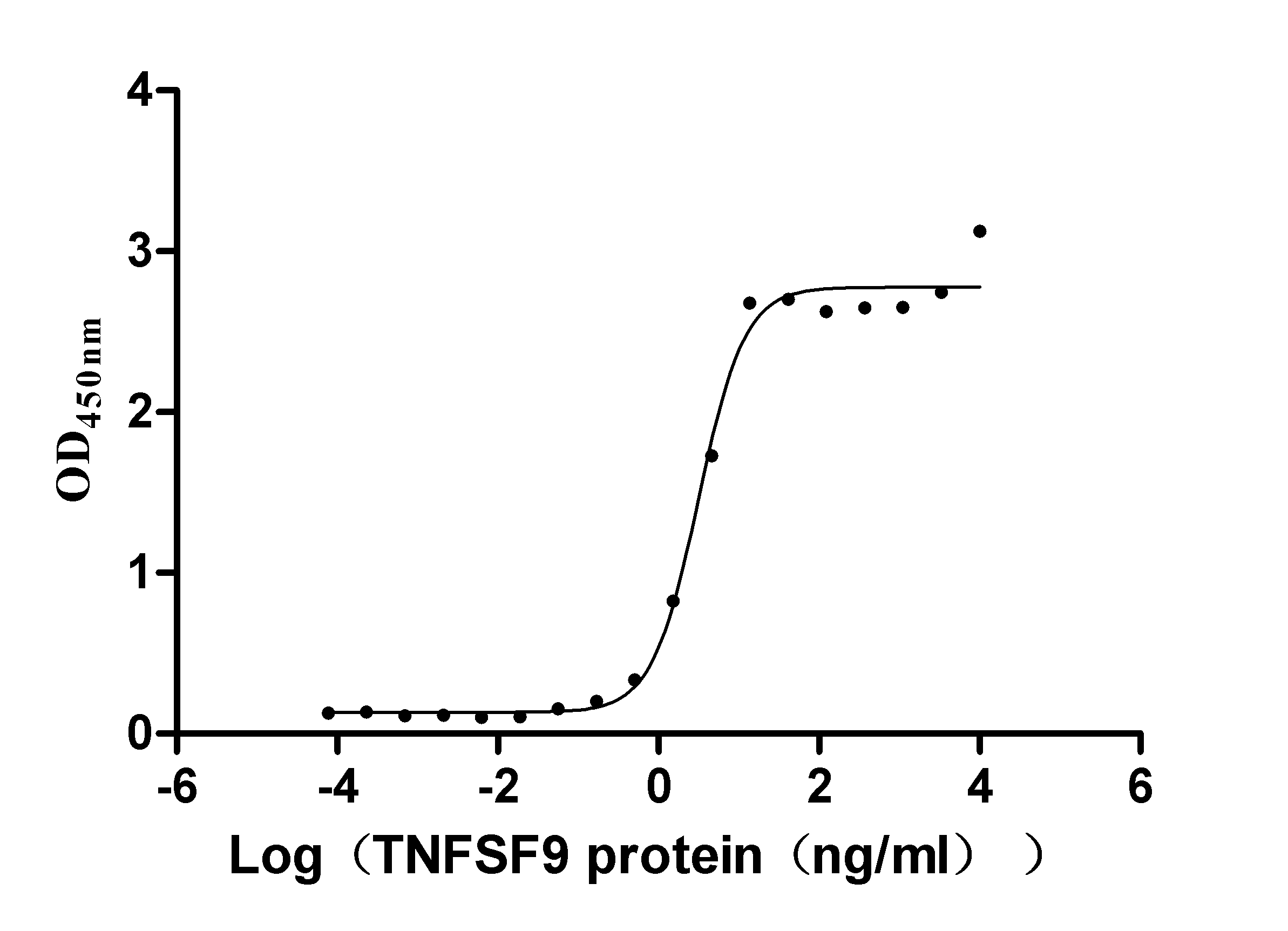Recombinant Mouse Peroxisomal targeting signal 1 receptor (Pex5)
-
中文名称:小鼠Pex5重组蛋白
-
货号:CSB-YP017805MO
-
规格:
-
来源:Yeast
-
其他:
-
中文名称:小鼠Pex5重组蛋白
-
货号:CSB-EP017805MO-B
-
规格:
-
来源:E.coli
-
共轭:Avi-tag Biotinylated
E. coli biotin ligase (BirA) is highly specific in covalently attaching biotin to the 15 amino acid AviTag peptide. This recombinant protein was biotinylated in vivo by AviTag-BirA technology, which method is BriA catalyzes amide linkage between the biotin and the specific lysine of the AviTag.
-
其他:
-
中文名称:小鼠Pex5重组蛋白
-
货号:CSB-BP017805MO
-
规格:
-
来源:Baculovirus
-
其他:
-
中文名称:小鼠Pex5重组蛋白
-
货号:CSB-MP017805MO
-
规格:
-
来源:Mammalian cell
-
其他:
产品详情
-
纯度:>85% (SDS-PAGE)
-
基因名:Pex5
-
Uniprot No.:
-
别名:Pex5; Pxr1; Peroxisomal targeting signal 1 receptor; PTS1 receptor; PTS1R; PTS1-BP; PXR1P; Peroxin-5; Peroxisomal C-terminal targeting signal import receptor; Peroxisome receptor 1
-
种属:Mus musculus (Mouse)
-
蛋白长度:Full length protein
-
表达区域:1-639
-
氨基酸序列MAMRELVEGE CGGANPLMKL ATHFTQDKAL RQEGLRPGPW PPGASAAETV SKPLGVGTED ELVSEFLQDQ NATLVSRAPQ TFKMDDLLAE MQEIEQSNFR QAPQRAPGVA DLALSENWAQ EFLAAGDAVD VAQDYNETDW SQEFIAEVTD PLSVSPARWA EEYLEQSEEK LWLGDQEGSS TADRWYDEYH PEEDLQHTAS DFVSKVDDPK LANSEFLKFV RQIGEGQVSL ESAAGSGGAQ AEQWAAEFIQ QQGTSEAWVD QFTRPGNKIA ALQVEFERAK SAIESDVDFW DKLQAELEEM AKRDAEAHPW LSDYDDLTSA SYDKGYQFEE ENPLRDHPQP FEEGLHRLEE GDLPNAVLLF EAAVQQDPKH MEAWQYLGTT QAENEQELLA ISALRRCLEL KPDNRTALMA LAVSFTNESL QRQACETLRD WLRYSPAYAH LVAPGEEGAT GAGPSKRILG SLLSDSLFLE VKDLFLAAVR LDPTSIDPDV QCGLGVLFNL SGEYDKAVDC FTAALSVRPN DYLMWNKLGA TLANGNQSEE AVAAYRRALE LQPGYIRSRY NLGISCINLG AHREAVEHFL EALNMQRKSR GPRGEGGAMS ENIWSTLRLA LSMLGQSDAY GAADARDLSA LLAMFGLPQ
-
蛋白标签:Tag type will be determined during the manufacturing process.
The tag type will be determined during production process. If you have specified tag type, please tell us and we will develop the specified tag preferentially. -
产品提供形式:Lyophilized powder
Note: We will preferentially ship the format that we have in stock, however, if you have any special requirement for the format, please remark your requirement when placing the order, we will prepare according to your demand. -
复溶:We recommend that this vial be briefly centrifuged prior to opening to bring the contents to the bottom. Please reconstitute protein in deionized sterile water to a concentration of 0.1-1.0 mg/mL.We recommend to add 5-50% of glycerol (final concentration) and aliquot for long-term storage at -20℃/-80℃. Our default final concentration of glycerol is 50%. Customers could use it as reference.
-
储存条件:Store at -20°C/-80°C upon receipt, aliquoting is necessary for mutiple use. Avoid repeated freeze-thaw cycles.
-
保质期:The shelf life is related to many factors, storage state, buffer ingredients, storage temperature and the stability of the protein itself.
Generally, the shelf life of liquid form is 6 months at -20°C/-80°C. The shelf life of lyophilized form is 12 months at -20°C/-80°C. -
货期:Delivery time may differ from different purchasing way or location, please kindly consult your local distributors for specific delivery time.Note: All of our proteins are default shipped with normal blue ice packs, if you request to ship with dry ice, please communicate with us in advance and extra fees will be charged.
-
注意事项:Repeated freezing and thawing is not recommended. Store working aliquots at 4°C for up to one week.
-
Datasheet :Please contact us to get it.
相关产品
靶点详情
-
功能:Binds to the C-terminal PTS1-type tripeptide peroxisomal targeting signal (SKL-type) and plays an essential role in peroxisomal protein import.
-
基因功能参考文献:
- monoubiquitination of the N-terminal cysteine of peroxisome-associated PEX5 not only functions to recycle the peroxin back to the cytosol, but also serves as a quality control mechanism to eliminate peroxisomes with a defective protein import machinery PMID: 26086376
- Demyelination in cerebellum and brain stem preceded major myelin loss in corpus callosum of Pex5 deficient mice. PMID: 22458306
- interaction of PEX5 with catalase and PEX14 PMID: 21976670
- Absence of peroxisomal metabolism in neurons and astrocytes does not provoke the neurodegenerative phenotype observed after deleting peroxisomes from oligodendrocytes. Lack of peroxisomal metabolism in astrocytes causes increased VLCFA levels in myelin PMID: 20578053
- Peroxisomes were selectively reconstituted in brain or liver of Pex5 knock-out mice, a model for Zellweger syndrome, by tissue-selective overexpression of Pex5p. We found that both rescue strains exhibited a correction of the neuronal migration defect PMID: 14586000
显示更多
收起更多
-
亚细胞定位:Cytoplasm. Peroxisome membrane; Peripheral membrane protein. Note=Its distribution appears to be dynamic. It is probably a cycling receptor found mainly in the cytoplasm and as well associated to the peroxisomal membrane through a docking factor (PEX13).
-
蛋白家族:Peroxisomal targeting signal receptor family
-
数据库链接:
KEGG: mmu:19305
STRING: 10090.ENSMUSP00000049132
UniGene: Mm.22418
Most popular with customers
-
Recombinant Human Tumor necrosis factor ligand superfamily member 9 (TNFSF9), partial (Active)
Express system: Mammalian cell
Species: Homo sapiens (Human)
-
Recombinant Human Poliovirus receptor (PVR) (I340M), partial (Active)
Express system: Mammalian cell
Species: Homo sapiens (Human)
-
Recombinant Rabbit Tissue factor pathway inhibitor (TFPI) (Active)
Express system: Mammalian cell
Species: Oryctolagus cuniculus (Rabbit)
-
Recombinant Human Claudin-3 (CLDN3)-VLPs (Active)
Express system: Mammalian cell
Species: Homo sapiens (Human)
-
Recombinant Macaca fascicularis lymphocyte antigen 6 family member G6D (LY6G6D) (Active)
Express system: Yeast
Species: Macaca fascicularis (Crab-eating macaque) (Cynomolgus monkey)
-
Recombinant Mouse Cytotoxic and regulatory T-cell molecule (Crtam), partial (Active)
Express system: Mammalian cell
Species: Mus musculus (Mouse)
-
Recombinant Human Tumor necrosis factor ligand superfamily member 15(TNFSF15) (Active)
Express system: Mammalian cell
Species: Homo sapiens (Human)



-AC1.jpg)




-AC1.jpg)










